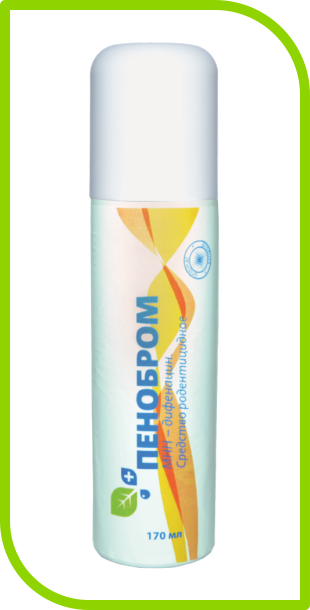
MANUAL
on the use of the rodenticidal agent “Penobrom” for the destruction of rodents
(Developer organization: LLC Firm “Biochempharm”,
Raduzhny, Vladimir region.)
I. GENERAL PROVISIONS
1. Penobrom is a foaming compound in an aerosol package containing 0.0005% of the active substance — bromadiolone.
2.Bromadiolone has an anticoagulant effect. Once in the animal’s body, it inhibits the formation of prothrombin by the liver, as a result of which blood clotting slows down, the walls of peripheral blood vessels are damaged, hemorrhagic diathesis develops.
It has pronounced cumulative properties. It has a skin-resorptive effect. The poisoning effect manifests itself no earlier than after 24-36 hours, usually the first signs of poisoning appear after 2-5 days. The rodents exposed die after about 3 weeks. During this period, the poison slowly accumulates in their body and other animals continue to eat the bait, without associating this particular product with the death of relatives.
3. The foam is stored at a temperature from 5°C to 25°C in the manufacturer’s closed packaging. In case of freezing of the foam composition, the cylinders are brought into a heated room and kept until complete thawing, after which the drug is again suitable for use.
4. The shelf life of the drug is 2 years from the date of manufacture.
5. With a single oral intake of LD50 ADV (bromadiolone) is for different animals, mg / kg: rats 0.49-1.125, mice 1.75, rabbits 1 (per skin – 2.1 mg / kg), dogs 8.1-10, cats 25, fish and poultry 1600 mg / kg. The lethal dose for a person with intragastric intake is 300 mg / kg.
II. USE OF THE DRUG
6. Penobrom is used for the manufacture of poisoned baits, deratization poisonous coatings and blockage of the entrance holes of rodent burrows.
7. Optimal foaming and trouble-free operation of aerosol packages is provided at a temperature of 45 ° C, for which, if necessary, it is recommended to warm up the balloon with the drug. Before use, the aerosol packaging is thoroughly shaken several times.
If the foam supply stops when the valve is pressed, the latter is removed from the cylinder head, replaced with another one or washed with water and purged with a pump or a rubber bag.
8. As the food basis of poisoned baits, the most attractive for rodents in specific conditions are used high—quality food products and feeds – grains of cereals, sunflower seeds, minced meat and fish, porridges, compound feed, bread crumbs, etc. At the same time, 1 kg of the food base is thoroughly mixed with 4-5 g of toxic foam, i.e. with the amount of it that is released from the aerosol packaging for 4-6 seconds.
The presence of poisoned bait on the treated area is provided for 5-7 days in places inaccessible to farm animals, taking into account the specific conditions of rodent activity.
For every 100 m2, 2-3 bait points are placed, increasing their number by 2-3 times when killing mice. Depending on the degree of population of objects by rodents, 50-500 g and 20 – 30 g of poisoned bait are laid out in each bait point when fighting rats and mice, respectively.
At facilities where rodents have a plentiful and diverse food supply, the basis of extermination measures are non-intrusive methods of deratization (treatment of rodent burrows, installation of poisonous coatings on their movement paths and in places of congestion). In combination with unprincipled methods, freshly prepared bait from the most attractive feeds for animals at this facility provides the best results.
The treatment of rodent burrows and crevices used by them with foam bromine is divided into:
– blockage of the entrance holes of rodent burrows (cracks);
– installation at the entrance holes of rodent burrows (crevices) of deratization poisonous coatings made of foam chrome.
For one entrance hole of the burrow (slit), the foam from the aerosol packaging of the drug is released within 6-10 seconds.
By means of visual observations of rodents and on the traces of their vital activity, the main ways of movement and places of animal clusters are recorded, on which deratization poisonous foam coatings of 50 cm by 25 cm are installed. Foam overlays are applied with a layer 2-3 mm thick. The death of rodents from poisonous coatings occurs as a result of ingestion by animals when cleaning their bodies of particles of a poisonous composition stuck to their outer coverings during various kinds of contacts with surfaces covered with a rodenticidal composition.
The number of toxic coatings installed at the facility should ensure that rodents pass through them daily and at least once for several days. To create a greater probability of such contact, an attractive food for rodents, poisoned bait is laid out next to the coatings.
Toxic coatings should be applied on a substrate of roofing, roofing material, cardboard, etc. The use of substrates allows you to change the placement of coatings in the course of deratization extermination work and reduces the contamination of the treated area with rodenticide.
The treatment of burrows, crevices, ways of movement and places of accumulation of rodents is carried out daily for 5-7 days. On the first day, these works are carried out in full on the entire treated area, and in the future they are repeated where the integrity of the poisonous overlays is violated by rodents.
III. PRECAUTIONS
9. It is forbidden to smoke and eat while working with Penobrom. Work with the poison is carried out in rubber gloves and respirators (cotton gauze bandages) that protect the skin and respiratory organs from getting rodenticides. After work, hands should be thoroughly washed with warm water and soap. Tables and dishes in which the bait was prepared are washed with a 2% soda solution.
Persons who have carefully studied the instructions for its use and who do not suffer from hemophilic disease are allowed to work on deratization using Penobrom.
Penobrom should be kept under lock and key in a special cabinet.
Rodent corpses need to be cleaned with a shovel, shovel, forceps or hands in rubber gloves. Collected corpses are subject to incineration.
10. Persons who are constantly working with the drug should be systematically under the supervision of a doctor. In case of suspected poisoning (the appearance of bleeding, hemorrhages on the mucous membranes, in the subcutaneous tissue, on the protruding parts of the limbs (elbow, knee joints), it is necessary to urgently consult a doctor. First aid and treatment measures consist in the use of vitamin K or preparations containing it.
11. In case of poisoning of farm animals, a course of specific and symptomatic treatment is carried out. As a specific remedy, blood transfusion containing a normal amount of prothrombin is used, or vitamin K or its synthetic analogues (vikasol, methionine) are prescribed. In mild cases of poisoning, recovery occurs after feeding animals increased amounts of alfalfa or fish meal containing vitamin K.








